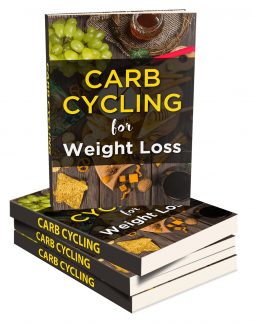 License Type: Master Resell Rights
License Type: Master Resell Rights  File Type: ZIP
File Type: ZIP
 SKU: 63142
SKU: 63142  Shipping: Online Download
Shipping: Online Download
Sample Content Preview
Introduction
What Is Carb Cycling?
Carbohydrates, sometimes called carbs, are an ongoing hot topic now. Some nutritional experts are starting to associate them with problems such as inflammation, diabetes and obesity. However, others continue to insist that they are an essential part of our daily diet.
So, are all carbohydrates bad for you? And how much carbohydrate should you eat every day? This is where carb-cycling can help.
Carbohydrates, along with fat and protein, make up the three macronutrients. When your body digests carbohydrates, they’re broken down into glucose – your brain and body’s preferred form of fuel. When glucose gets into the bloodstream, the pancreas is triggered to produce a hormone called insulin. This transports glucose from the bloodstream into the cell. Here, it is turned into energy, stored in the fat cells or stored as glycogen.
When you embark on a carb-cycling regime, you can reduce body fat while increasing muscle mass. It’s an extremely rigorous diet so it should only be used in the short-term. However, it is useful for breaking through weight-loss plateaus.
Carb cycling relies on increasing and decreasing carbohydrate intake on different days of the week. There are high-carb days and low-carb days as well as days on which no carbs are eaten at all. When you try carb cycling, you can eat carbohydrates if they’re from a clean source. The cycling allows the body to use fat more effectively as a fuel instead of burning muscle tissue and carbs.
In this book, we’ll take a closer look at what carb cycling is all about. We’ll look at how you can get started and how to determine whether it’s right for you. This will allow you to make a well-informed decision.
Chapter 1: Benefits of Carb Cycling
Carb cycling isn’t ideal for everyone. However, it can prove to be a useful solution in the right circumstances. There are two main groups of people who can benefit from trying out this eating regime: Those who need to lose weight, and those who want to increase their muscle mass while boosting their sporting performance.
Do I Need to Lose Weight?
Some experts suggest that carb cycling is especially beneficial for anyone who needs to lose weight. In theory, this way of eating can help you to maintain your physical performance. It also provides many of the identical benefits offered by low-carb diets such as the Atkins regime. These kinds of diets can leave dieters feeling lethargic and weak. Therefore, carb cycling offers a clear advantage.
Like any other diet, the primary mechanism behind losing weight is to maintain a deficit of calories. You need to eat less food than the body can burn over an extended period. When you adopt carb cycling along with a deficit in calorie intake, you’ll almost certainly lose weight.
Carbohydrates aren’t bad for you. However, the role of carbs is to supply an energy source for your body to burn through when you’re active. If you aren’t carrying out enough physical activity and are still eating a lot of carbohydrates, problems arise. Your body ends up storing the excess as fat.
Carbs are a great choice when you’re working out hard in the gym. Your body will burn rapidly through them to produce energy. It burns carbs rather than protein, so this nutrient can boost muscle-growth.
If you aren’t training hard, those extra carbs aren’t being burned up quickly. Therefore, the body stores all the unused glucose in the fat cells. This results in you becoming overweight or even obese.
On the other hand, if you restrict carb intake, your body cannot store the excess glucose. Instead, it turns to fats to produce energy rather than starchy or sugary foods. As a result, your body can shed fat, helping you lose weight.
Hoarding additional calories is all well and good if you have a very active lifestyle. Yet, if you aren’t moving around much, you cannot use all those calories. This leads to obesity. You therefore need to vary your carb intake from day to day. If you’re going to be hitting the gym, you can eat more carbs. If you’re going to be watching TV for most of the day, you should restrict your intake.
Another reason why carb cycling is so good for weight loss is because it makes it hard to overeat. Foods with a high carb count are usually more indulgent. We all know how hard it is to resist the urge to eat another cookie or a delicious, sugary donut. It’s a lot harder to binge eat on vegetables and proteins. Very few people will over-indulge on chicken or broccoli! Therefore, you’ll be consuming fewer calories and helping your waistline.
As carb cycling is a flexible way to diet, it can be more appealing to dieters. Knowing that you can indulge in carbs occasionally can be attractive. One of the reasons why so many people fail with other diets is because of their restrictive nature. Knowing you can never eat pasta or bread can be off-putting from the start. This leads to dieters giving up after a short while. Carb cycling’s flexibility can encourage these people to adhere to the program. As a result, they’ll lose more weight overall and maintain a healthier bodyweight.
There is also a key link between levels of insulin in the blood and carb intake. If there is a high level of insulin in the blood, fat storage becomes more likely. In turn, this hinders effective weight loss. You should take care about changing your carb intake if you’re taking insulin for diabetes. Therefore, talking to a doctor is key.
Healthy eating must also lie at the heart of any carb cycling plan. It isn’t an excuse to restrict eating to excess or over-indulge on unhealthy food. Meticulous tracking is required to be successful at carb cycling. This can promote an unhealthy attitude towards eating. Therefore, you need to take care to stay in perspective when adopting this regime. If you find it’s negatively affecting your life in this way, you should stop and choose a different eating plan.
Am I a Bodybuilder?
Carb cycling remains a popular strategy for nutrition for athletes and bodybuilders. Those who are physique competitors are especially keen on this way of eating. They depend heavily on no or low carb days in their competition preparation cutting phase. Since glycogen is primarily water, manipulating your carb intake changes the appearance of muscles onstage. Meanwhile, creating a surplus of energy by consuming more carbs promotes better muscle gain.
Many athletes use their way of eating to minimize their fat gain and maximize their muscle gain during training. They must strictly adhere to a daily menu which is based on their body composition and energy expenditure. Also, a carb cycling program will regulate the amount of fat and protein being consumed.
A higher protein intake is necessary to promote muscle growth during carb cycling. Protein must therefore be around 30 percent to 35 percent of daily calorie intake. Carbs in a low phase should be around 10 percent to 15 percent of total intake. These should primarily be composed of fresh vegetables.
High carb days should fall on days of intense training. This will ensure muscle recovery is faster and essential nutrients are provided. By having targeted carb intakes and regular periods of high carbs, your performance can improve.
For athletes participating in endurance sports such as swimming, cycling and running, this is good news. Varying carb intake through the year helps to increase stores of muscle glycogen.
Carb cycling optimizes the carb load so there’s enough fuel to burn when working out intensively. Nevertheless, excess carbs won’t be stored as far when you’re having a non-workout day.
Elite athletes have been eating this way for some time. They believe it helps them to boost their workout performance. At the same time, they can build muscle while maintaining a healthy bodyweight.








